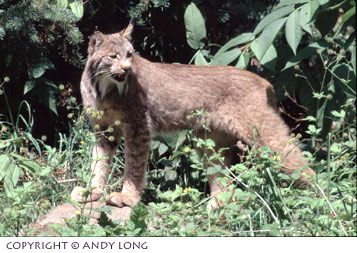
When you think of life cycles in nature, several examples might come to mind — the mating, nest building and hatching of birds; the rain of spring and wildflowers of summer; perhaps even the changing colors of trees in fall and new growth of spring.You may think of more, but one cycle that might not leap readily to mind is a set pattern in the rise and fall of a specific animal species.
One animal that wouldn’t seem to have a problem with numbers is a prime illustration–the snowshoe hare.Most people wouldn’t expect an animal that has such a high rate of reproduction to experience any difficulties with maintaining population, even for a short time.However, hares’ high rate of reproduction is the precise reason why their numbers drop.Once their numbers reach large enough proportions, their food supply has to suffer.And it does–about once per decade.(A single decade is the approximate time period the vegetation in an over-exploited area takes to regenerate.)Their decline in population doesn’t affect snowshoe hares alone.The animals that depend on them as a food source suffer, as well.One of those animals is the lynx.Research has concluded that the reproduction and survival rates of the two species go hand-in-hand. Sadly, the lynx and the snowshoe hare are not the only animals that suffer through this type of cycle.
The lynx, unlike many other species, will still mate and give birth in lean years—although few kittens will survive in a season of very low food availability.While there might be other food sources around, they remain dependent on hares.The lynx requires about three pounds of meat a day, and one snowshoe hare fills that need perfectly.To find enough mice or voles to make up the same amount of meat, the cat would have to spend a lot more energy hunting.When a lynx has the luxury of choosing hares as a primary meal, it can spend much of the winter resting and conserving much-needed body heat and energy.
Lynx have acquired some special adaptations in order to survive, especially during the long winters in their northern range.The most basic of these are their wide, furry paws which act like snowshoes to distribute the animal’s weight over the snow.In addition, a lynx possesses long legs to carry it through deep powder.Another winter ally is their ear tufts, which keep the tips of their ears from freezing.The ear tufts also enhance sound.
With the lynx living in and around the boreal forest, they enjoy special adaptations of their eyes.First, their eyes have the ability to react quickly to sudden changes in lighting to enable the cat to go quickly from light to dark and vice versa.To chase hares successfully, they need this ability, because hares will run into the forest from an open field in order to avoid being caught.Second, their eyes are set in the front of their head to allow a wide field of overlapping vision, which gives them the depth perception needed to pick out a white hare against a white background of snow.
Behavior
Size – An adult male may weigh up to forty pounds with a length of thirty-two to thirty-six inches.The females are slightly smaller.
Mating – Breeding takes place in late winter.Usually, one to four kittens are born sixty to sixty-five days later.Females do all of the rearing of the newborns by feeding, protecting, and teaching them survival techniques.A female with young will need to catch at least two hundred snowshoe hares a year to insure her survival and that of her kittens.
Range – With snowshoe hares being their primary source of food, lynx must have a large home range.Some studies have estimated lynx ranges to be as large as sixty to sixty-five miles.Since each lynx needs this amount of territory (they are primarily solitary animals and very territorial), a very large area is needed to maintain a viable population.Another problem lynx have in finding good population areas is that they won’t cross large areas of cleared land.Therefore, it would be difficult for them to re-colonize many of the areas they once roamed.They’ve been forced to move farther into the wilds that have decreased dramatically over the years.
Hot Spot – While the best places to find lynx are in Alaska, there are several areas where their numbers are adequate in the lower forty-eight states.The state with the largest concentration is Washington.The forests of the Olympic Peninsula, as well as the forests of the central part of the state, offer the best chances for hopeful photographers.Look along snowshoe hare trails in heavily wooded swamps.Like housecats, lynx like to lie spread out on inclined logs during the day, soaking up the sun.
By Andy Long

Leave a Reply